John Chayka's Reverse Moneyball
The Coyotes are are an expensive and mediocre mess - and it's not because of analytics.

In the 2017-18 season, the Arizona Coyotes were the National Hockey League's thriftiest team, spending only 58.8 million dollars against the salary cap of 75 million. The franchise - notorious for having to play just above the cap floor due to low revenues and a challenging ownership situation - seemed like just the challenge for 27 year old John Chayka, who had been hired one year previously. Chayka was heralded as the first of a new wave of analytics-minded general managers; he was the co-founder of Stathletes, a hockey analytics firm premised on the detailed tracking of microstats unavailable to the general public. Surely such a forward-thinker was the right guy to "Moneyball" a low-payroll team to greatness, identifying undervalued players and making the tough decisions that the old boys don't have the courage to make.
Three seasons later, Chayka and the Coyotes have shocked the NHL. Not in terms of team success (the team has finished 28th, 29th, 18th, and 22nd since he was hired), but in terms of their cap situation. Arizona was - improbably - right at the cap limit in 2019-20 according to CapFriendly, and in terms of active player cap, the Coyotes have only ~$2M in cap space. How the hell did this happen? The way that Chayka has built the Coyotes could almost be called reverse Moneyball: rather than spend frugally on the right players, the team has a bloated payroll and little to show for it. They have cut against the grain, not in terms of shrewd frugality but in terms of spending lavishly and long-term on middle-of-the-roster players.
It was inevitable that the success of the Arizona Coyotes under Chayka would be seen by most in the mainstream hockey media as the final verdict on the role of analytics in hockey. If he succeeds, hey, maybe there’s something to analyzing the sport using advanced metrics. If he fails, it’s vindication for the hockey men, and we can put the spreadsheets away for good. I think there is a tendency among some in the stats-savvy community to play into this duality, and act as apologists for guys like Chayka when they make bizarre decisions - at least they have the process right, and they must have internal numbers guiding them! But not only is this is exactly the kind of appeal to authority that analytics were supposed to dislodge, but it also forces us to go down with the ship.
This article will go very - excessively - in-depth in an attempt to fully analyze John Chayka’s tenure with the Coyotes from an analytical perspective. It will make two arguments: that Chayka's success (or lack there of) should not be seen as an indicator for the validity of “hockey analytics” as a whole, and that despite some isolated good moves he has built the Coyotes incoherently, without vision, and in direct contradiction to what analytics as most people understand them would have dictated. It will lean heavily on macro-level models such as EvolvingWild’s Goals Above Replacement model to assess moves made based on how they looked at the time and how they turned out.
No True Analytics GM
To most hockey men, the “analytics movement” is a coherent monolith of people who all value the same thing (Corsi? right?) and the same players. They would rather have Cody Franson than Drew Doughty, don’t care about defence or grit, and wish everyone was speedy and skilled. But that’s not the case. At the very least, there are two identifiable general schools of hockey statistical player analysis:
Macro-level on-ice impact models based heavily on shot rates/quality (e.g. HockeyViz, Evolving-Hockey)
Micro-stat tracking quantifying on-ice events (e.g. SportsLogiq, Stathletes)
These two sides often overlap, and many people try to combine the two to form a more full picture of a player. (sound familiar?) That’s because they serve different functions, both related to the dreaded “eye test.” Microstats function essentially to quantify the eye test, addressing the problem of comparability. A regular viewer can only say that it seems like Niklas Hjalmarsson prevents zone entries quite a bit, while a stat tracker could tell you exactly how often he does it and how he compares to other defencemen. “Macrostats” like Micah McCurdy’s Magnus and EvolvingHockey’s Goals Above Replacement essentially supplant the eye test, addressing the problem of scope. Rather than overcoming the problem that a viewer can’t possibly keep track of exactly how many times a player does something, they overcome the problem that sometimes in hockey (especially on defence) what matters isn’t just “events” (like a smart poke check or a puck carried in) but things that don’t happen; furthermore, the eye test can't isolate the impact of a player from his linemates or team. These models boil hockey down to its essentials - the object of defence is to prevent your goalie from facing quality chances against, the object of offence is to generate quality chances and score on them.
So if these can fit together nicely, where does the divide come in - and what does this have to do with Chayka? Well, oftentimes the microstats and the macrostats disagree. A lot. Andrew Berkshire of Sportsnet writes, citing SportsLogiq microstats, that Drew Doughty remains elite, while his isolated macro on-ice impact has plummeted. TruPerformance notoriously claimed, based on their tracked stats, that in 2016 Kris Russell was better than Marc-Édouard Vlasic, who at the time was the league’s best defensive defenceman according to macrostats. Recently I have had arguments over Aleksander Barkov in which his extremely poor defensive macro-level impact has been dismissed because of stick checks and puck battles. In my opinion, microstats have value for the same reason the eye test has value - it tells the story of how results came to be, and helps us understand how players and teams play. The macrostats tell you that Jack Johnson is bad defensively, and the microstats tell you how Jack Johnson is bad defensively. But because microstats function as EyeTest+, they have many of the same downfalls, and when they’re leaned upon too heavily they tend to miss the forest for the trees. Another big difference? Macrostats are typically public, because they can be put together by talented staticians using publically available data, while microstats (with exceptions like Corey Sznajder) are “proprietary” and “exclusive” because they require manpower and time to manually track. Microstats are an industry, macrostats are publicly scrutinizable.
Why does this matter? Because microstats are significantly more palateable to mainstream hockey minds than macro-level models. Take it from Dave Staples, just a few months after Chayka was hired:
Folks who put a lot of weight in Corsi analytics don’t believe [Kris Russell] is a very capable NHL defenceman, if he’s capable at all. But in cutting edge NHL circles there’s a new and growing focus on tracking analytics, where huge teams of video analysts go over games in detail, focusing on the individual contributions of players, looking at exactly what these players do to help their team win and lose.
Because microstats quantify, rather than challenge, the almighty eye test, they are a welcome compromise for organizations who would otherwise be hostile to analytics. They use coach-friendly language like “zone entries” and “transition passes” rather than “expected goals” and “regularized adjusted plus-minus.” And they are far easier to cherry pick from - with such a wide range of tracked stats, it might be possible to make almost any player look good (like Kris Russell). A microstat slides neatly onto a scouting report which would otherwise be entirely contradicted by a macrostat.
We don’t know exactly how John Chayka runs his team, nor the exact types of metrics he uses. We only have his background and his record as evidence, and they both point in the same direction. Chayka was the founder and CEO of Stathletes, a company which specifically bills itself as an intensive stat tracking service offering “ultra low-level analysis” - i.e. a microstat tracking company. And the moves he has made over the course of his tenure have overwhelmingly not been in line with macro-level analysis. I would argue that this is likely the divide between his reputation as the Analytics GM and the actual choices he has made. The point here is that just because the Coyotes clearly use stats and data to make hockey decisions does not mean that they have built their team on Corsi, or Expected Goals, or heat maps, or WAR - which means that their lack of success is not even close to proof that assessing hockey players and teams with stats is wrong.
What Chayka Has Done Right
The Goaltending
The obvious strong point of the Arizona Coyotes’ current roster is their goaltending, thanks to two players who Chayka acquired in trades. Antti Raanta was clearly too good to be stuck behind Henrik Lundqvist in New York, having put up a very strong 8.7 and 6.7 goals saved above expected in backup ice-time in 2015-16 and 2016-17 respectively, and since he came to the desert he has been the league’s 3rd best goaltender by that metric. In 5th place? Darcy Kuemper, traded to the Coyotes from the Los Angeles Kings in exchange for nothing of much value. Unlike Raanta, Kuemper’s track record was very spotty before the trade, but he was in the midst of a by-far career-best performance with the Kings. Goaltending, as I've said many times, is a crapshoot - it’s not reliable from year to year. Maybe Kuemper will turn back into a pumpkin next year, and injuries will keep hindering Raanta. But for all of the good fortune in net that Chayka has enjoyed, he undoubtedly put himself in as a good a position as possible.
(One thing to note, just speculatively, is that goaltending is relatively tough to “microstat” since the goalie has one job - stopping the puck. Microstats for goaltending would only track how good a goalie is at stopping the puck in different circumstances (cross-crease passes, for example). Is it possible that that’s why an analytical approach has served Chayka’s search for goaltending well?)
Jakob Chychrun
We don’t have a huge sample size for Chychrun, but based on this season it appears as though drafting and extending him long-term were both excellent decisions. He was a player with a high ceiling, and even though the trade they made to draft him was a bit odd (20th overall + a 2nd for 16th overall and a huge cap dump?), he has been worth it. He’s on a straight upward trajectory right now which makes it very likely that he will provide the Coyotes with a lot of surplus value on his contract.
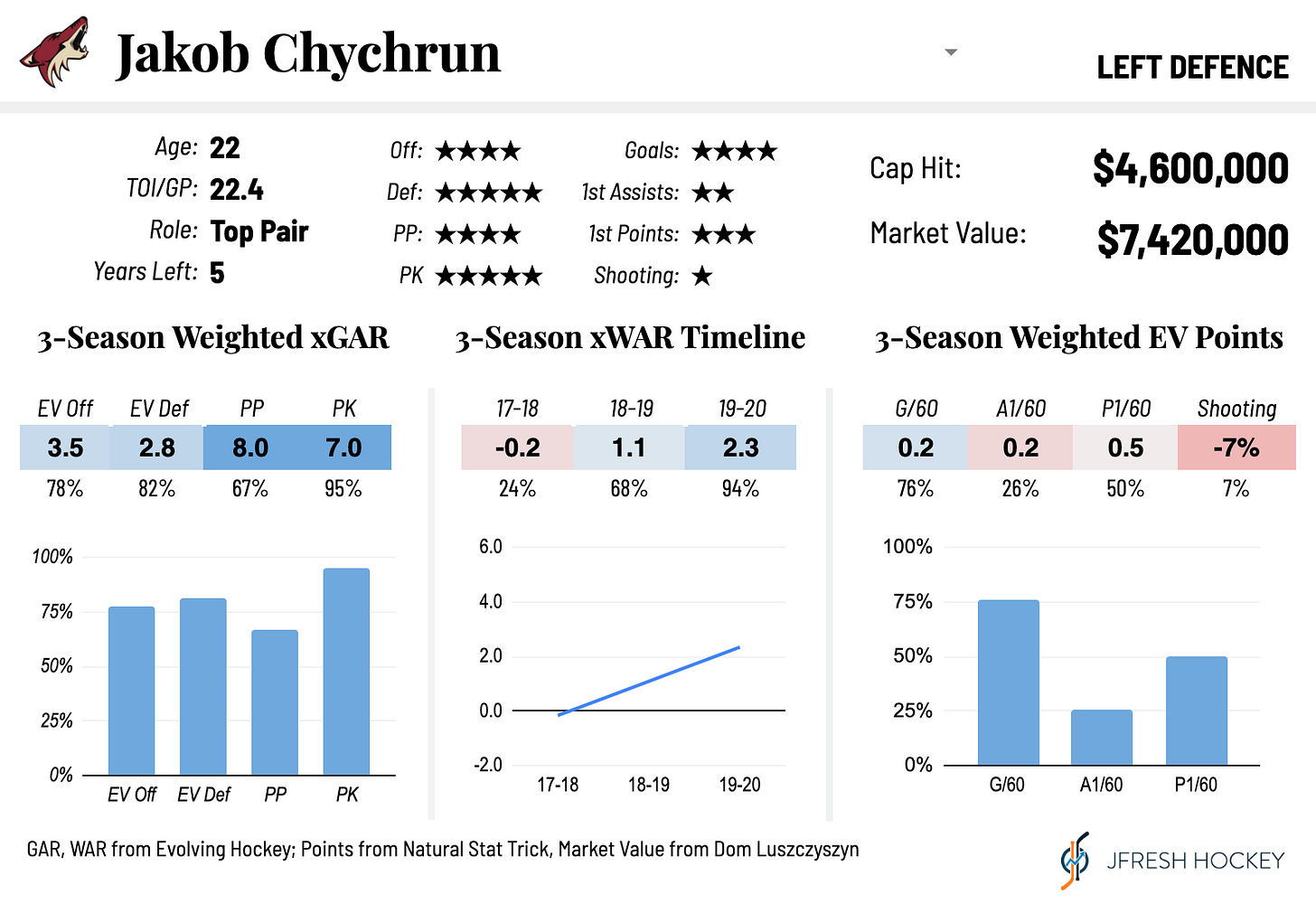
Niklas Hjalmarsson
Acquiring Niklas Hjalmarsson from the panicking Blackhawks at far below his fair value was good work by Chayka. Hjalmarsson remarkably never dipped below the 92nd percentile among defencemen defensively over the course of the entire 2010s, the rare example of a stay-at-home-defenceman who actually fits the billing. Now, Connor Murphy (the main piece going to Chicago) has hugely improved in the past two seasons and has actually outperformed Hjalmarsson over that stretch. Hjalmarsson also struggled mightily in an abbreviated 2019-20 season after signing a two-year extension. But unless he repeats this injury-affected season and is a liability next season, Hjalmarsson has still been the stronger playdriver by a large margin since the trade was made. Chayka deserves the win on this one.
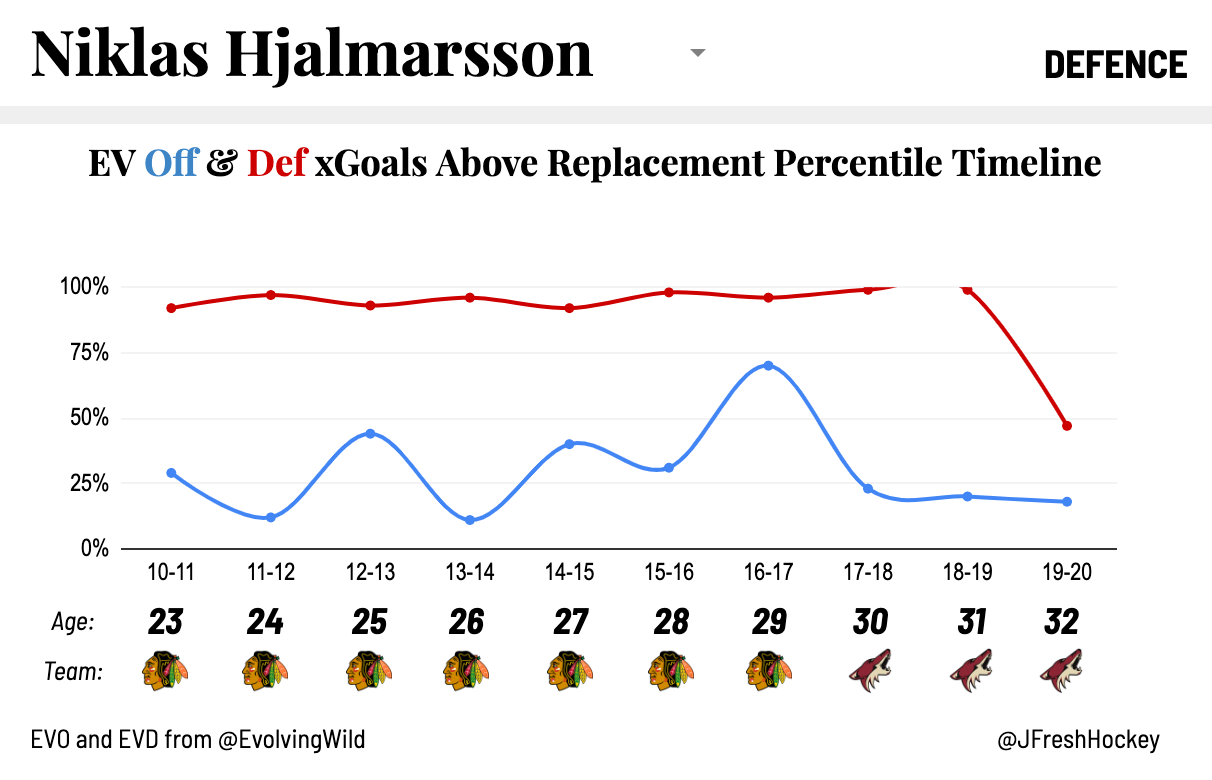
Depth Trades
Chayka has managed to find some decent pieces as throw-ins or minor pieces in trades. This includes Vinnie Hinostroza, Nick Cousins, and Richard Panik. These are the kinds of inexpensive middle six players you want, and even though only Hinostroza remains on the team, I credit Chayka and his scouting team for identifying them as targets.
Bad Stuff That You Can’t 100% Blame Him For
Derek Stepan
Derek Stepan, acquired from the Rangers in 2017, has not worked out. At all. As soon as he got to the Coyotes, at the reasonable age of 27, his play completely collapsed. Only this season did it even begin to somewhat recover. This is not the kind of thing that Chayka can be held fully responsible for, because it is a matter of hindsight. At the time of the trade, Stepan profiled pretty clearly as a decent top six centre, pretty okay across the board and overall worth his contract.
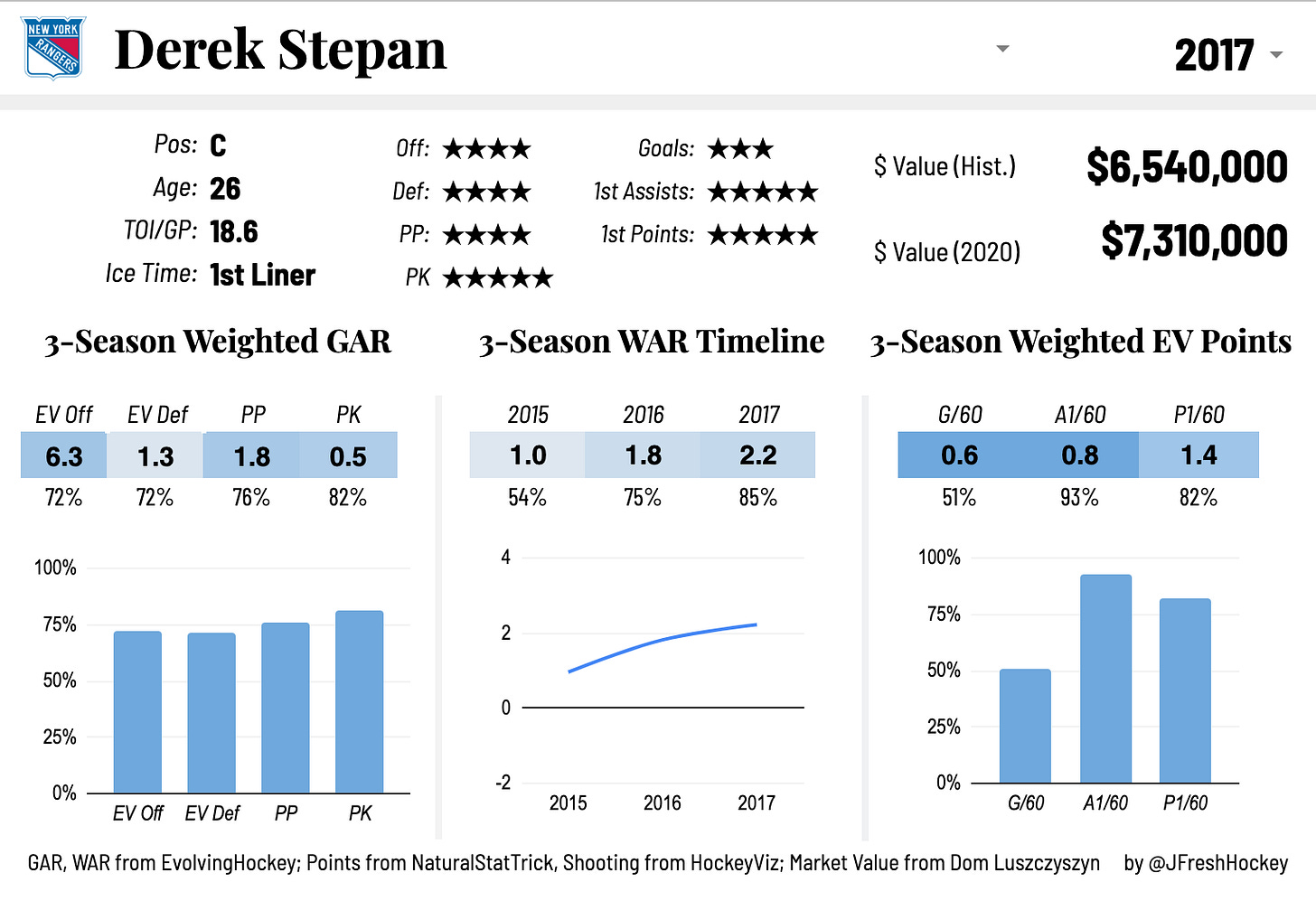
However. In 2016-17, Stepan had the benefit of playing 43% of his ice time with Chris Kreider and Mats Zucarello, two players who were better than him at the time. Kreider was a 92nd percentile even strength goal scorer, and Zucarello a 92nd percentile primary assist-er and 94th percentile WAR player. Stepan was a big part of that line’s success, and Zuccarello in particular saw a big drop-off once he left. But he wasn’t the straw that stirred the drink on his unit. And sure enough, when he was cast in that role in Arizona, his play fell apart, in no small part due to Tobias Rieder (previously referred to in this article as “nothing of much value"), Brendan Perlini, Clayton Keller, and Richard Panik being his most common linemates instead.
So while I won’t say that Stepan’s drop-off is something Chayka should have fully anticipated, trading a 7th overall pick for a low-end 1st line centre who had never really been the best player on his line (and inevitably would be in Arizona) was a questionable endeavor from the word “go”. I also include trading Tony DeAngelo, who went to the Rangers as well in this deal, in this category - his development into a great RD doesn’t look great for Arizona, but he was always a project and I personally don’t blame a manager for wanting to get him out the door.
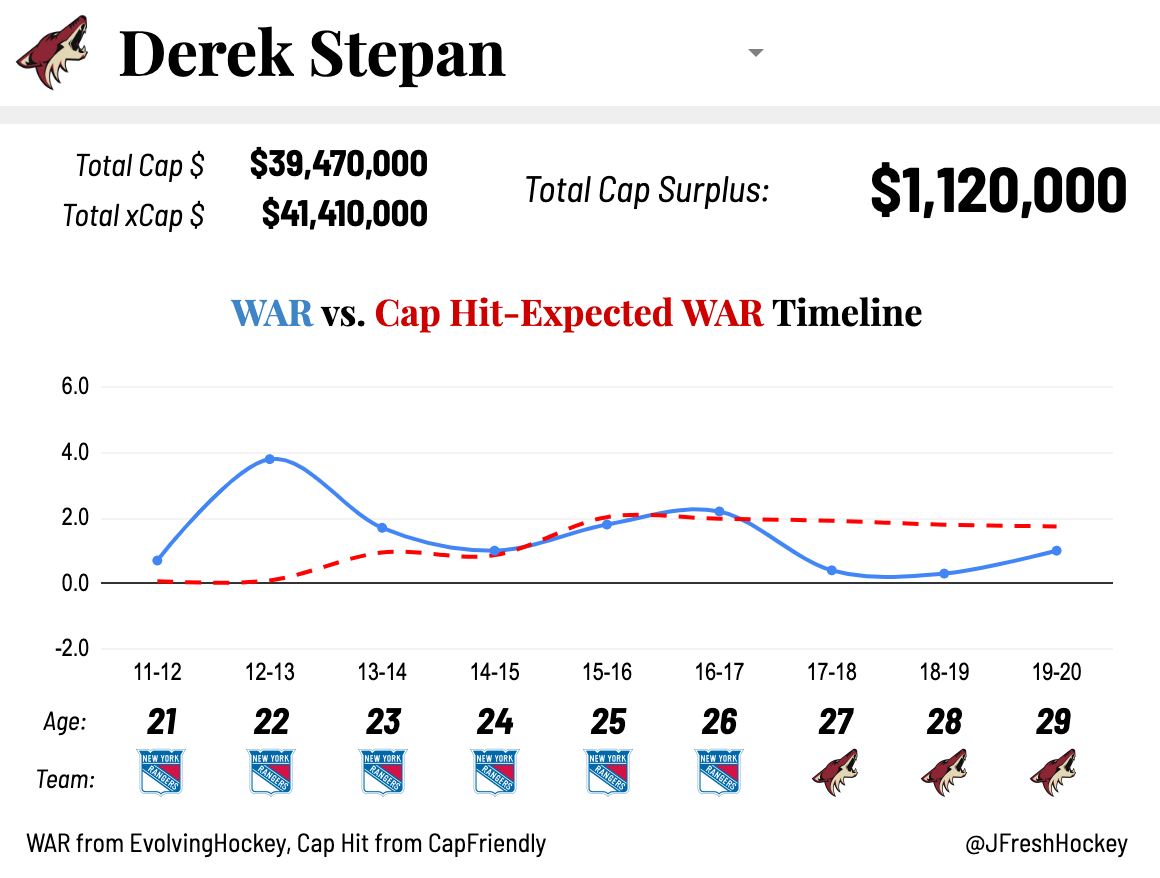
Oliver Ekman-Larsson
This one really fits this category. Chayka really had no choice but to sign Oliver Ekman-Larsson, the team’s franchise defenceman and captain. Could he have received a huge return for him in a trade? Yes. (Remember those OEL-for-Matthews-pick proposals?) But he would have had to have complete unassailable job security for that even to really be an option. The captain signed a max-term extension on July 1st 2018, a year before becoming an unrestricted free agent that pays him $8.25M per year until he’s 35. At the time, it was seen as a perfectly reasonable deal.
However. This contract, which didn’t kick in until this season, is already shaping up to be one of the worst in the league. OEL has not played well in the two seasons since signing it, and with seven years left to go things could get even worse. Hindsight is 20/20, yes, and Chayka was in a very constraining situation. But the warning signs were there. Here’s Ekman-Larsson as he profiled on the day that contract was signed.
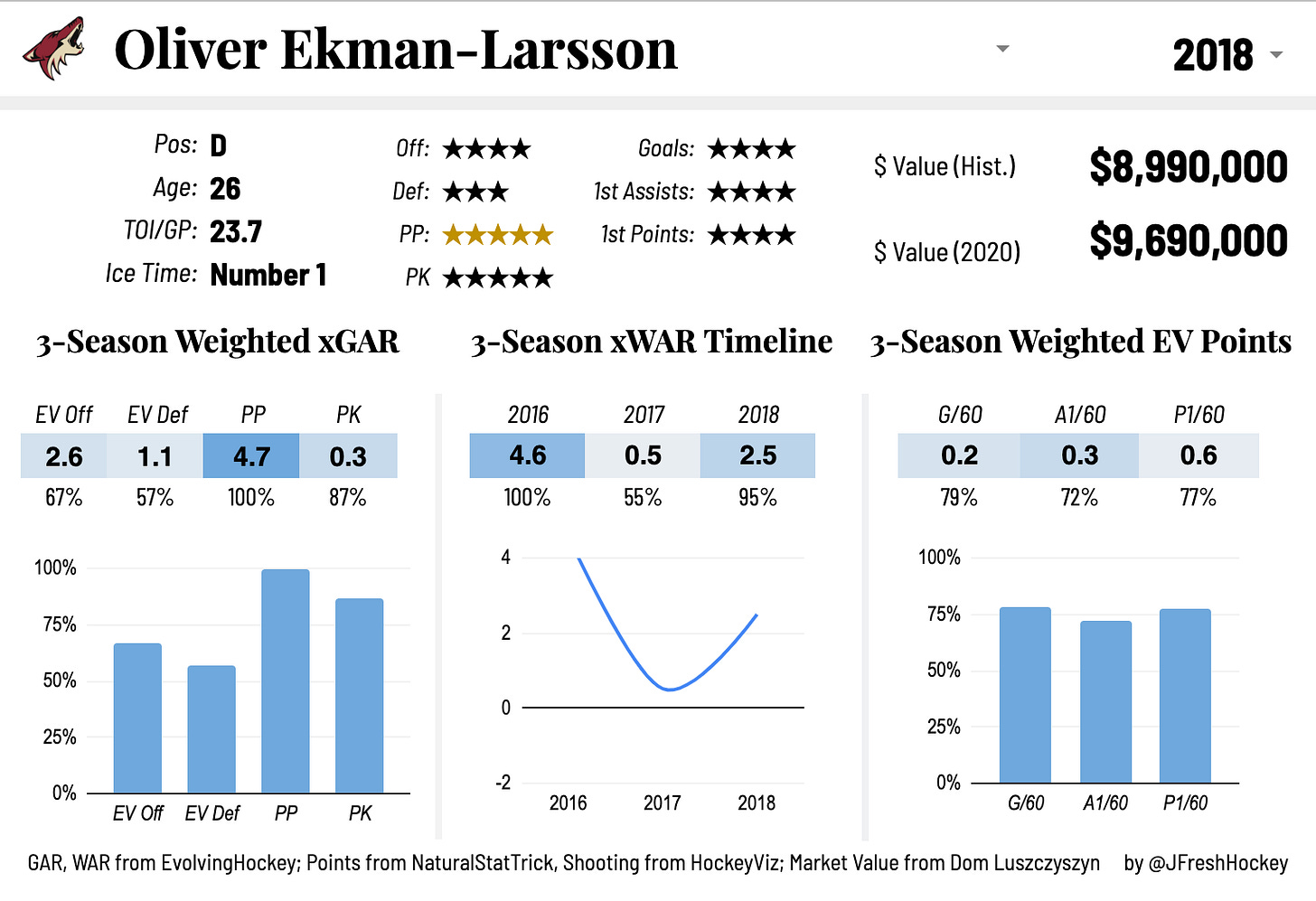
Based on the cap value estimation, the Coyotes theoretically got a discount (by coincidence, his expected cap hit for the 2017-18 season was exactly $8.25M). But check out his situational breakdown: his even strength play was surprisingly only above average at both ends, and he provided the majority of his value on the powerplay. He was also extremely inconsistent from season to season. Even strength play is most important (it’s more predictable, less influenced by external factors, and of course makes up the vast majority of ice time). Let’s see how Ekman-Larsson stacked up to players who signed comparable contracts for the three years before signing their extensions. To do this, I’ll use a slightly different version of the stats on the above card: even strength goals above replacement per 60 minutes adjusted for shooting (for a reason I specify here). Here’s the result:

Of the six players signed to similar deals in the three seasons before the OEL deal, Ekman-Larsson is 5th offensively, 3rd defensively, and 5th in total. The only worse player signed for $1.75M less. The broader takeaway here is that by July 1st 2018, he was only a slightly above-average player at both ends of the ice at even strength. Paying OEL that money was a bad idea from the start, and the term makes it even worse. That he has not lived up to the money should not have been a huge surprise.
So while Chayka didn’t have much of an option on this one, you can’t just completely brush aside the signing of one of the worst contracts in the league - especially when there were already red flags to begin with. If we can make fun of the Kings for the Doughty contract, we can at least mildly do the same to the Coyotes.
Bad Stuff You Can and Should Blame Him For
The Long-Term RFA Extensions
There is a virtue in the idea of locking up young players at low numbers. The Nashville Predators built the league’s best defence with three elite defencemen making $2.5M, $3.75M, and $4M on multi-year contracts. Every GM wants to be the one with those contracts on his books - especially a business-school graduate like Chayka. He has extended a number of young players longterm, including Christian Dvorak, Jakob Chychryn, Nick Schmaltz, and Clayton Keller, and it is these contracts that are primarily responsible for the Coyotes’ proximity to the cap. Most of these contracts were bets on potential, signed in the hopes that these players would prove to be worth the money.
After signing Dvorak, Chayka explained the strategy:
Obviously, there’s a few different ways you can go about working with a player coming out of his entry-level deal. You can let it play out the three years and make a determination from there, you can look to bridge him, you can look to do term. Our view is that this is a player that we want as part of our group for the long term. We could wait it out, make him play another year. In that regard, we just think he’s getting better and better, the market is going to continue to rise and we felt like this was a deal that made sense for both sides at this time.
The Hockey News’ Jared Clinton directly compared this to those Preds’ contracts:
In some ways, the play here with Dvorak is somewhat akin to the strategy the Nashville Predators have employed en route to having the most cost-effective lineup in the NHL. It’s the type of deal the Predators have handed players such as Roman Josi, Mattias Ekholm and Calle Jarnkrok in the past.
Here’s the thing, though. Those Nashville contracts weren’t bets on potential. With the exception of Josi, each of those players had already performed either up to the money, or far exceeding it. Using a WAR-to-expected-cap-hit formula created by Dom Luszczyszyn of the Athletic, we can calculate what they were “worth” the year before their contracts kicked in. Compare the numbers to the Coyotes’ extensions:
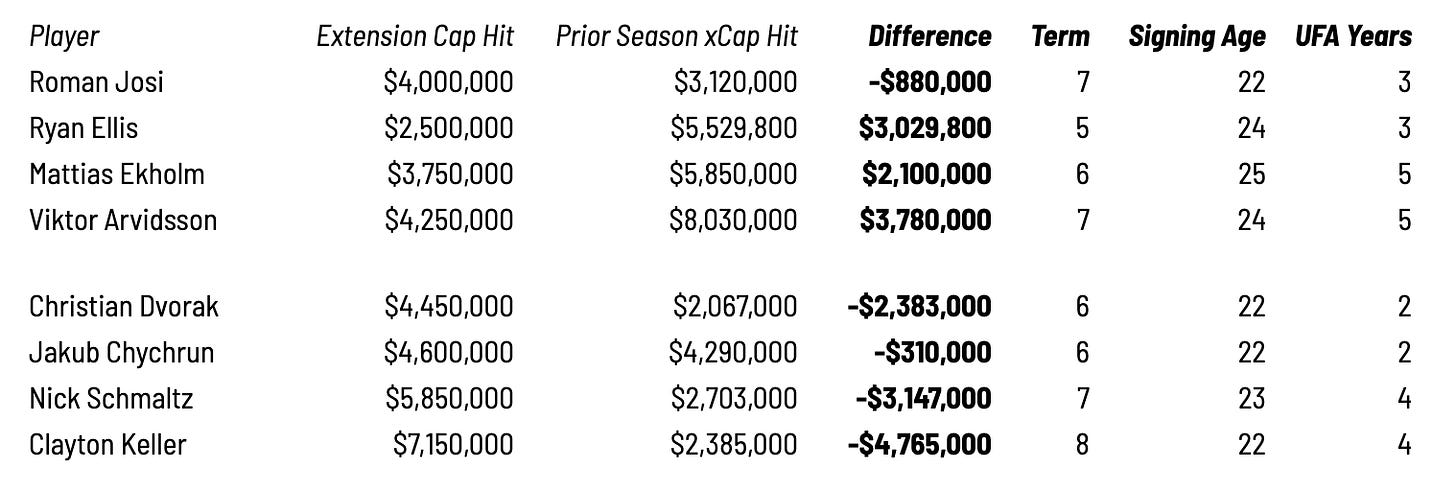
In effect, what the Predators did was a lot more like “Moneyball” - they realized that these guys were asking for less than they deserved, and took advantage of this to save precious cap space. There are a few other differences. The Coyotes made bets on players who were younger than the Preds did, and as a result bought fewer UFA years in aggregate. They also spent a good amount more of the cap on them. Aside from Chychrun, none of these players has demonstrated the upside that would require the kind of pre-emptive extensions involved. While Schmaltz and Dvorak both technically provided fair value on their cap hits this year in terms of WAR, they are at the age when contending teams need to get surplus value from their contracts. As any analytics GM knows, players’ “primes” tend to come earlier than it is traditionally thought; around 23-25 years old. It is smarter, then, to take advantage of the contradiction between that and the RFA system in order to fill out the rest of your lineup. Schmaltz and Dvorak also scored 45 and 38 points respectively this season, not the statistical profiles that tend to break the bank in restricted free agency.
And what about Clayton Keller? He’s by far the highest paid RFA contract on here. Here’s how he profiles at the time the extension was signed. Slightly above-average offensively (in terms of GAR and production), very poor defensively, not a good special teams player. His WAR expected cap hit is almost exactly half of what he would end up receiving.
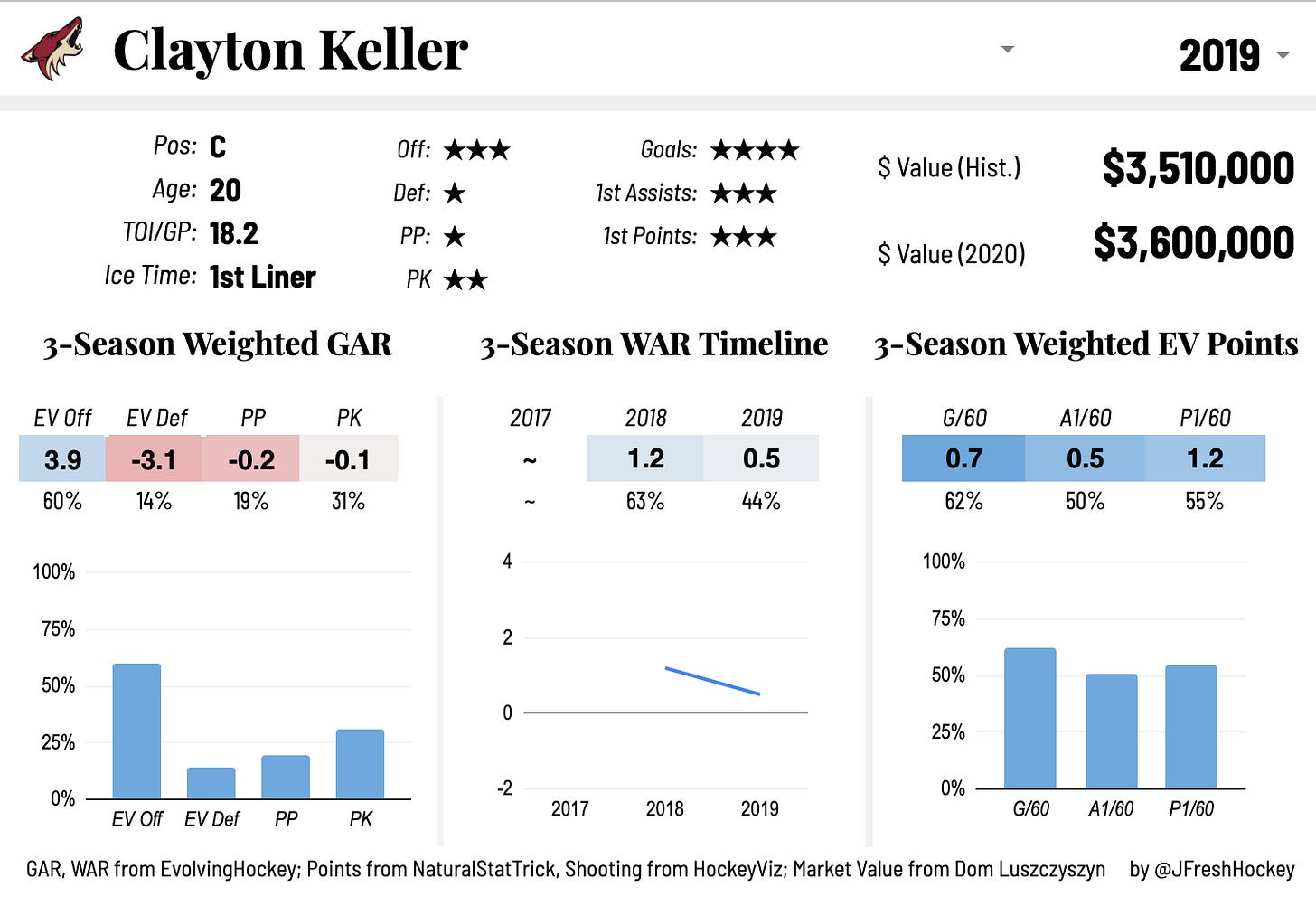
The Keller bet was made purely on potential, and it was a pricey one. He got paid mostly for his rookie season, when he scored 65 points (41 at even strength). The next season he had a pretty clear sophomore slump, as his offence took a pretty significant step backwards. When he decided to sign Keller to that extension last summer (a year before his ELC was up), Chayka made two bets:
Keller just had a sophomore slump and he will become a much better player than he was as a rookie, let alone in his second year.
If we wait to do this next summer, Keller will have a big season and we will have to pay $8M+ on his new long-term contract.
He bet wrong. Keller played better than he did in 18-19 but still worse than his rookie season, finishing with 44 points and 0.7 WAR (47th percentile). Defensive improvements (presumably a point of focus with his coaches) came at the expense of his offence generation.
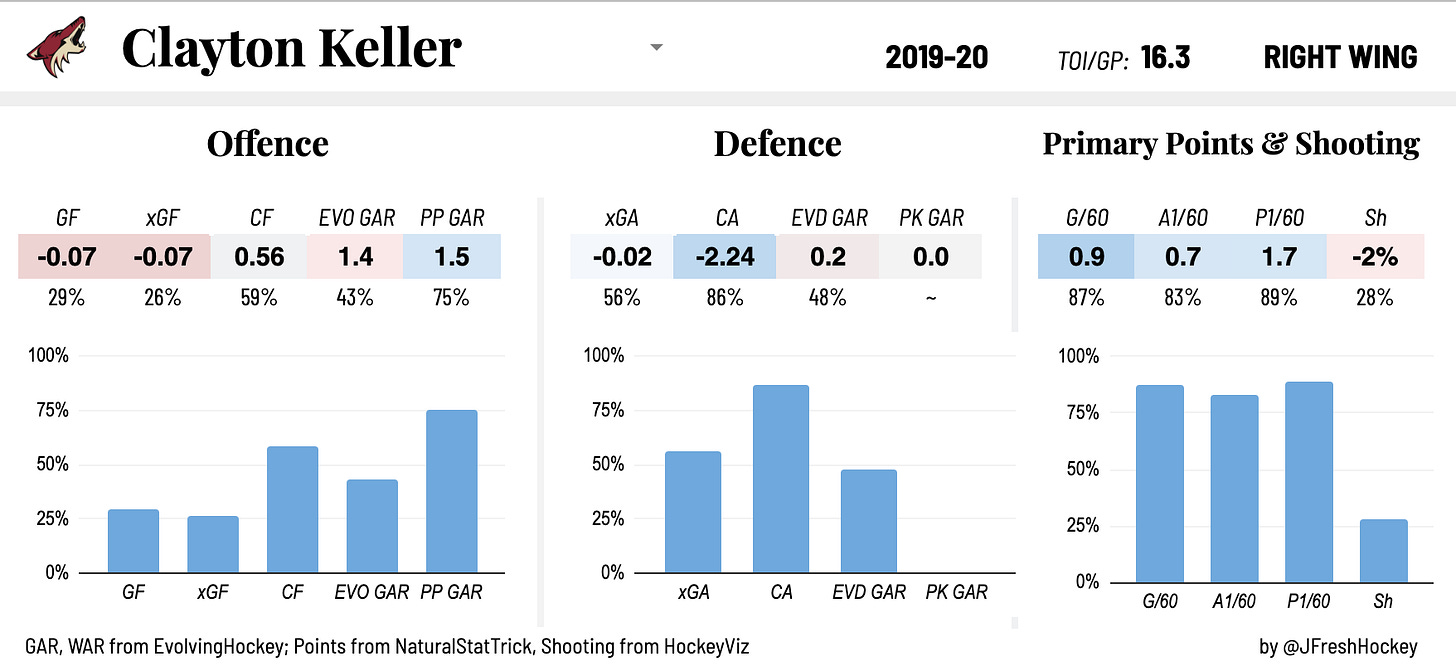
For Keller to live up to that contract at any point in the next few years, he will need to provide the Coyotes ~2 wins above replacement. He has never exceeded 1.2. There is a good chance that he has not yet reached his prime, but he’s going to need a huge leap to provide the team with fair value for their money.
The result of these extensions? The Coyotes are now - somehow - capped out, and a lot of that money is locked in for a very long time. They lack a single “core” forward, but rather have supplementary middle-six pieces locked in at cap hits far exceeding their RFA value. This means they have made it extra difficult to pursue the kind of top-end forward talent they desperately need. Chayka tried to emulate the Predators and find sweetheart good-value long-term deals, but instead of taking advantage of undervalued RFA-aged players who were known quantities, he made a series of expensive bets on player potential that is by no means a guarantee.
Targeting the Wrong Players

The main draw of hiring a GM who has built their reputation on analytics is that they can use unconventional methods to identify effective players who are undervalued or underpaid by more traditional teams. Statistical analysts can also do the inverse, avoiding bad decisions that other management teams might be prone to making. John Chayka has not provided the Coyotes organization with either benefit. With few exceptions he has not targeted “analytical darling” players, and he has repeatedly made poor personnel decisions that any analyst could have told him were really bad ideas. He has given unrestricted free agents bad multi-year contracts, given up good assets for almost nothing in return, and acquired expensive players with disastrous statistical profiles. He has, in other words, done what any regular ol’ GM who can’t even open Excel probably would have in his place.
Chayka hasn’t tapped into free agency very often, which is probably for the best for two reasons: firstly, July 1st contracts end very badly for the teams involved more often than not. Secondly, he’s really not good at it. Here’s his signing record so far:

Of the six unrestricted free agents that Chayka has signed for >$1M, only two were paid less than “fair value” based on their previous year’s performance - Jamie McGinn in an outlier year, and Luke Schenn. Only one - Radim Vrbata - went on to provide the Coyotes with surplus value.
One of the first moves that Chayka made was to acquire and sign 30 year old left defenceman Alex Goligoski to a five-year contract worth $5.475M annually. The purpose of this move was to slot the veteran into the top four spot behind Ekman-Larsson. Goligoski had just score 37 points playing big minutes on the contending Dallas Stars' top pair - exactly the kind of defenceman that teams tend to pay in free agency. He was one of the most underrated defencemen in the NHL in the early years of the decade and again in 2014-15. But his defensive game collapsed the season before the Coyotes signed him, at just about the age you would expect his game to decline. And sure enough, Goligoski has only barely lived up to his contract in two of the four years (17-18 and 18-19) while being a defensive liability throughout - and he still has a year left after this one.
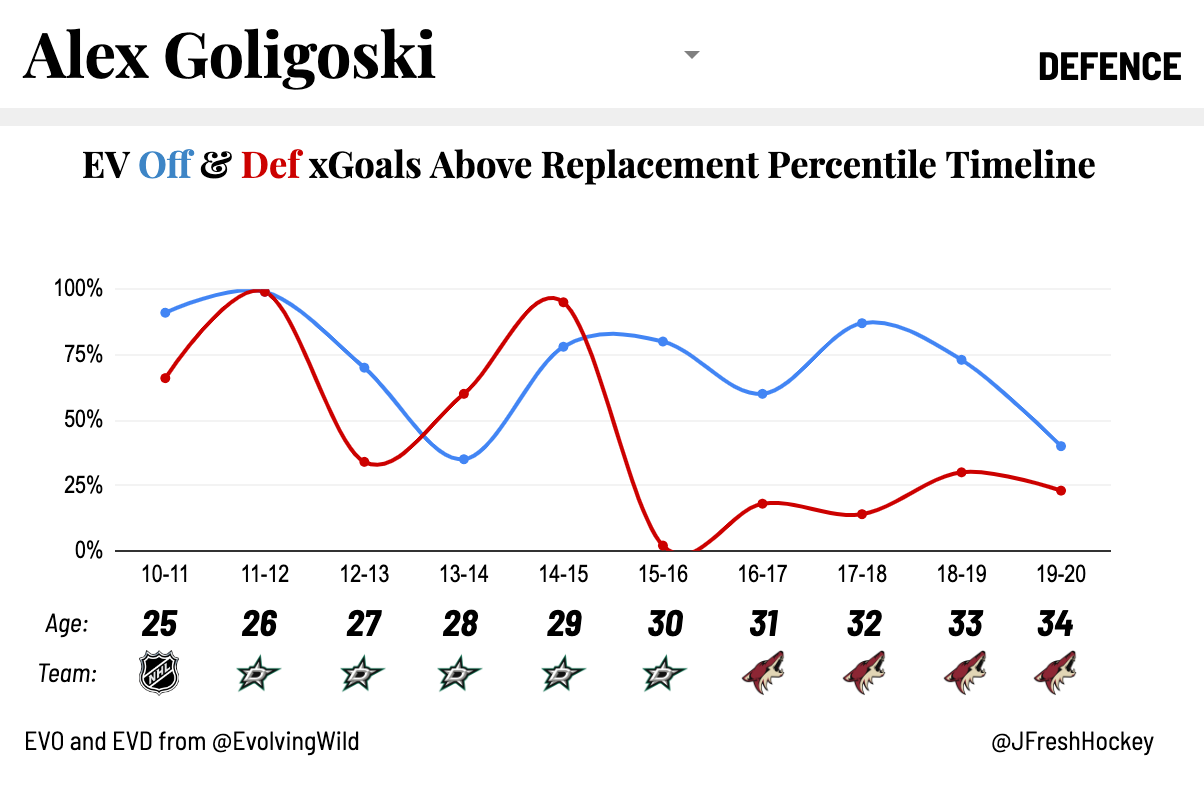
Similarly, in 2018 he signed Michael Grabner, a player whose “eye test” attributes (speed) have almost always eclipsed his on-ice impact, to a three year contract with a no-trade clause. His time in the desert has been predictably uneventful.
How about another Alex G? Sure, some fans ridiculed Bergevin for giving up on struggling forward Alex Galchenyuk for Max Domi, a guy who couldn’t even freaking score goals! But that doesn’t mean this trade is a “hindsight is 20/20” thing.
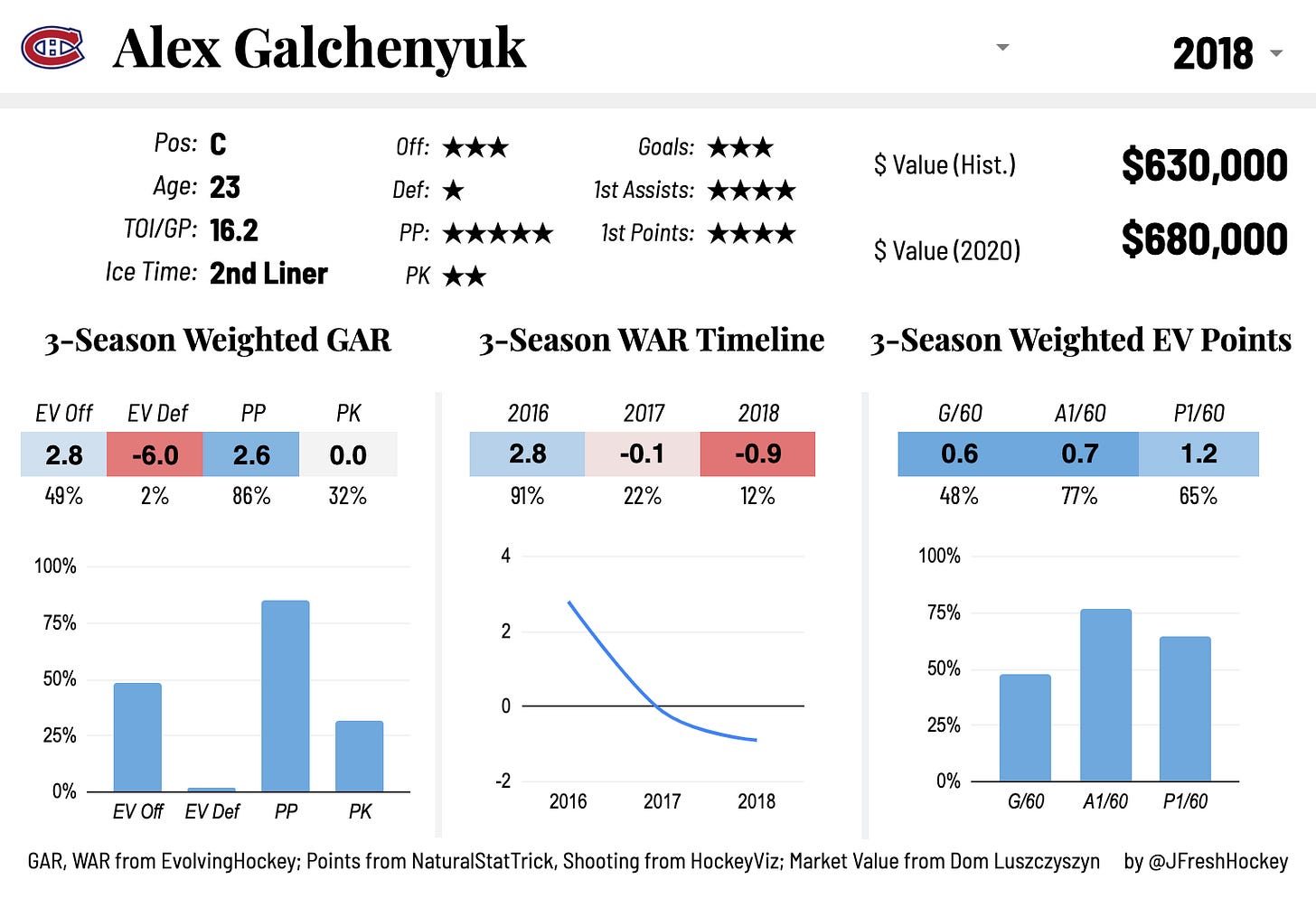
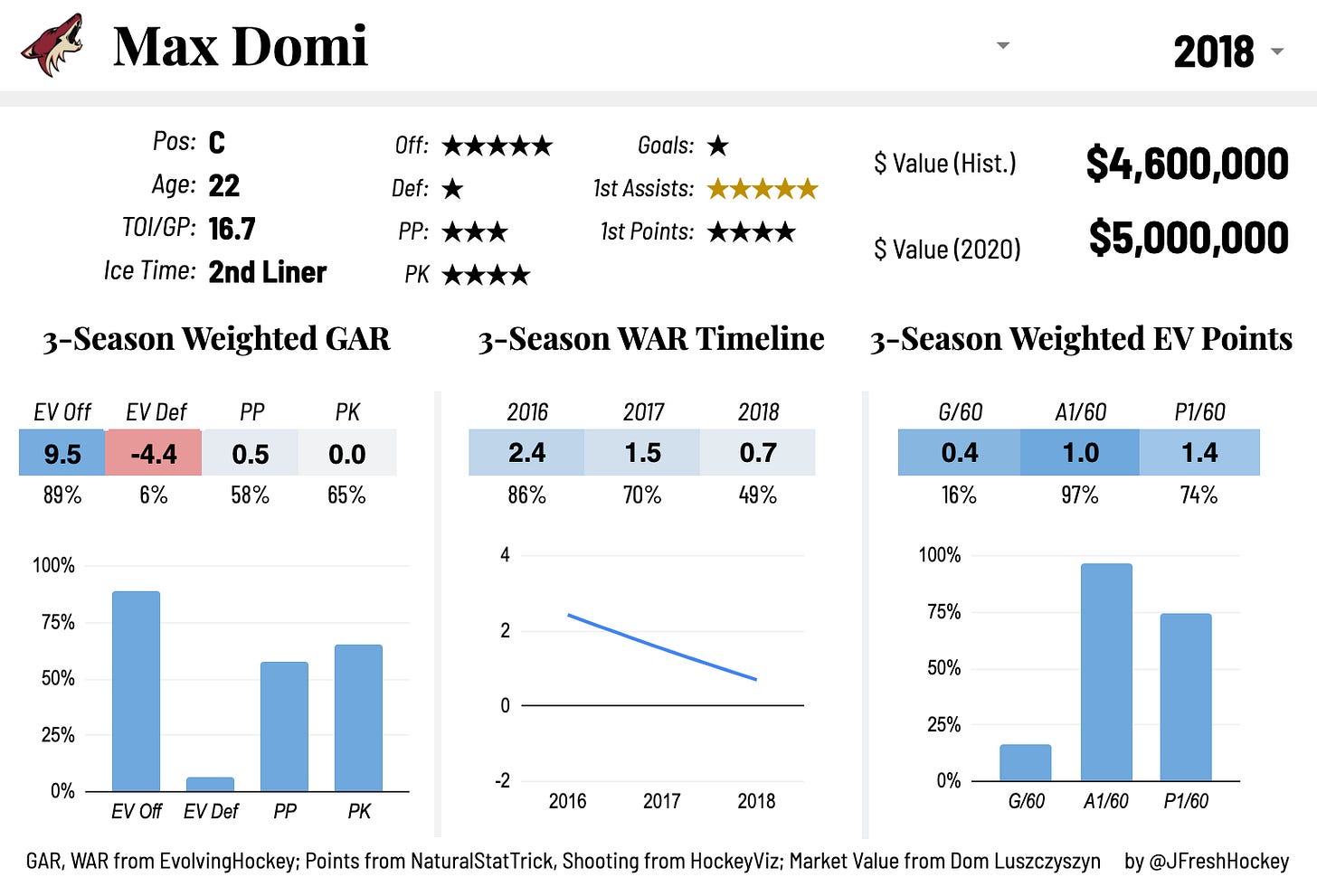
These guys had some things in common: they were young second-line forwards on downward trajectories who were horrible defensively. But there are differences, to say the least. Galchenyuk had been below-replacement level for two consecutive seasons, culminating in a brutal 2017-18 campaign in which he was a 12th percentile forward. He was below-average offensively at even strength, and one of the worst defensive players in the entire league. He was even a below-average goalscorer at that point. He had suffered a knee injury in 2016-17 and his performance had completely collapsed in the year and a half afterwards. Domi, on the other hand, never even came close to below replacement level, looking at worst like a slightly-below average player. Meanwhile, his playmaking talent was still clearly present - he was an 89th percentile offensive player and 97th percentile in primary assists per 60 minutes at even strength.
The only edge that Galchenyuk had on Domi was goalscoring - and he wasn’t even that good at that by 2018. The move would really only make any sense if the Coyotes were one of those teams that generates good chances but desperately needs someone who can finish. They weren’t. They were 27th in generating expected goals in 2017-18, having been 29th in 2016-17. Sure, they needed scoring badly, but it was more of an offensive play problem than a finishing problem. Trading away their 3rd best expected goal driver for a guy who was a below-average in that regard was not the way to go.
Maybe trading Domi was necessary. But Galchenyuk wasn’t a project - he was a prayer. Chayka made an incredibly risky bet and lost, badly. But hey, at least he traded Galchenyuk the next year, which I’m sure went great!
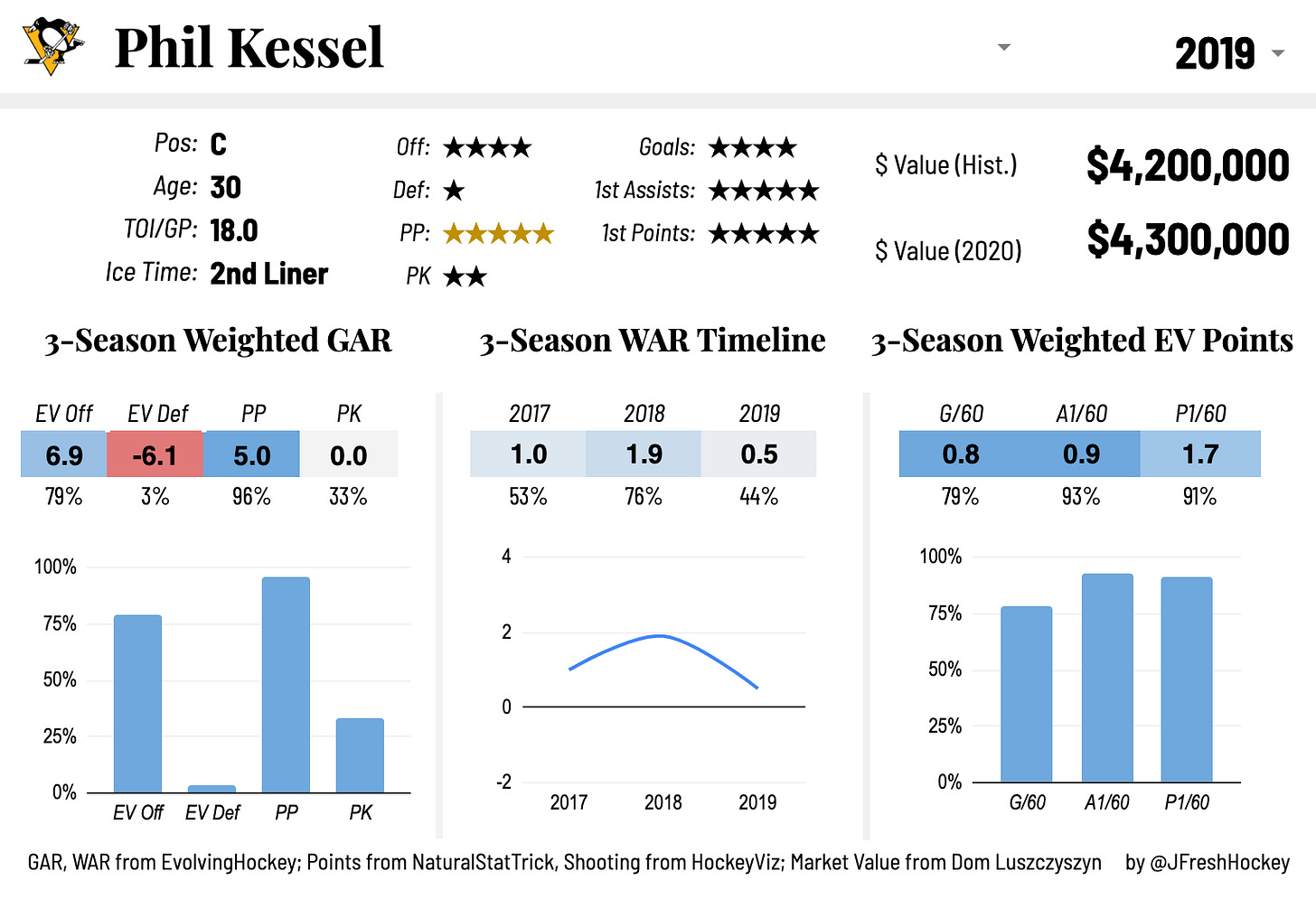
Acquiring Phil Kessel is not an analytical move. It’s a move you make when you are so desperate for someone who can score goals that you are willing to put up with absolutely anything else. In that sense, it’s almost fitting that he was traded for Galchenyuk. An analyst should see the age, the defence (even worse than Galchenyuk’s), the reliance on a spot on a star-studded Penguins’ powerplay, the $6.8M cap hit, and the three remaining years and stay far away. Even Phil’s offence at even strength had taken a hit, 69th percentile in terms of EVO goals above replacement in 18-19. A more qualitative observer would say that Rick Tocchet was his favourite coach in Pittsburgh, that the Coyotes needed goals, and that in 2015-16 he seemed to be good at being the best player on his line. Hey, it’s worth a shot!
Sure enough, he was an utter disaster this season, appalling offensively on both the powerplay and at even strength. On a team strapped for cap space, he will be a huge anchor moving forward. Once again, Chayka made a longshot bet - that a 31-year old Kessel would provide enough goalscoring and powerplay help to make up for his other deficiencies - and lost.
How about one more bad bet? I’m not going to clobber Chayka because Taylor Hall had a historically poor contract year. But I am going to point out that the Coyotes were by no means on track for playoff contention when that trade was made. On December 16th, the Arizona Coyotes were 1st in the Pacific Division, but there was only a two point divide between them and fourth-place Calgary. They were also only barely break-even in terms of xGF% (50%), a below-average shot attempt team (48%), and had a ~66% chance of making the playoffs according to Dom Luszczyszyn’s playoff projections. And even if they did make the playoffs, nobody in their right mind would consider them a contender for a deep run. Spending a 1st round pick + on a rental as a non-contender is a sign of desperation on Chayka’s part, and - once again - the gamble didn’t pay off.
A Lack of Vision

A lot of fuss was made in 2016 about the vision that John Chayka had for the Coyotes - a cutting-edge, data-oriented team that would rebuild the right way. Looking over the last four years, it's almost impossible to identify what that vision actually was.
Was it a traditional rebuild? The Coyotes traded Max Domi, Anthony Duclair, Dylan Strome, Tony DeAngelo, a 7th overall pick, and a 2020 1st within four seasons. The only blue chip player in their system right now is Barret Hayton, and while he's highly touted there is no guarantee that he will become a #1 centre. Meanwhile, they signed Alex Goligoski, traded for Derek Stepan, Niklas Hjalmarsson, Phil Kessel, and Taylor Hall; they have a goalie tandem over thirty, and are spending to the cap. These are things you do when you're desperate to make the playoffs.
But this team was never realistically going to contend with the win-now pieces he acquired. Derek Stepan, barely worth his contract as the third-best player on his line in New York, now cast as the #1 centre on a rebuilder? Alex Goligoski, entering his thirties and already clearly declining defensively? Phil Kessel, always an empty-calorie scorer, now past his prime and put back in the starring role for the first time since 2015? These guys didn't come cheap either, and are a big reason this team is inexplicably one of the biggest spenders in the league.
The Coyotes rebuild was a failure, yielding as of now only Chychrun, Dvorak, a vastly overpaid Clayton Keller, and Barret Hayton. If Hayton doesn't develop - and considering all of the young players who have thrived only once freed from the organization, would it surprise anyone? - this franchise doesn't have an apparent path to competitiveness. This team is built to make the playoffs by the skin of its teeth, and it can't even do that. Chayka hasn't built an analytical darling, or a dynamic young rebuilder, or a good mix of vets and youth. He's built a mess.
What's the plan now? Apparently to hope desperately that Taylor Hall is willing to sign a top-dollar long-term contract coming off a miserable season. Another huge bet. Well, at least he's due for a win.
Conclusion
The Coyotes badly needed a manager with a clear vision and the ability to create a competitive advantage in player evaluation and acquisition to make up for their dubious finances. Chayka possesses neither. This team is run reactively and expensively, making massive gambles for no reason - not young and talented enough to become a contender in the near future and not good enough to even make the playoffs now. This is not the fault of analytics. As I've shown, macro-level stats consistently contradicted the decisions that Chayka has made that have proven to be bad.
Arizona presented an opportunity for a new kind of hockey management, one which would spend precious (and scarce) salary strategically on good value contracts and players who might be underrated by the rest of the league. Investments could go towards player development, rather than the kinds of bloated veteran contracts that teams so often give out. Instead the Coyotes are up against the cap with no playoff appearances and a below-average prospect pool to show for it.
John Chayka may not be a good general manager, but he’s a spectacular salesman. He sold the people who run the Coyotes on handing the keys to their floundering franchise to a 27 year old. He sold large swaths of the media on a vision for a data-savvy stat-smart organization. He sold pending UFA Alex Goligoski on signing a contract before July 1st. He sold Oliver Ekman-Larsson on extending his contract rather than seeking a huge open-market payday and potentially joining a contender. That's a hell of a talent. But it takes more than charisma to build a winner. The business school degree was worth the money - this Coyotes team? Not so much.

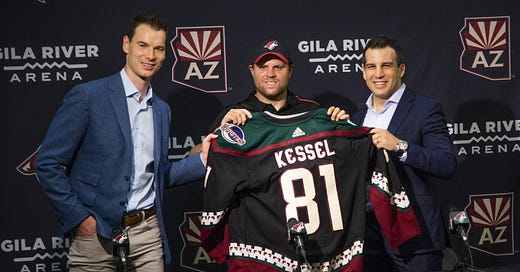


Enjoyed the detailed perspective, buy didn't have enough time to fully explore all you presented. Looking forward to delving into the comparison graphics.
Agreed wholeheartedly regarding OEL, Stepanek and Kessel. Would be interested in your evaluation of Conor Garland's contributions to the Coyotes. For the price I believe he can be a major factor in moving the Coyotes towards becoming a viable contender. But so many other pieces are needed to allow his true talents to thrive.
You are so spot on. I don't have the statistical capabilities of you, but said so many of the same things in my own words. Your last paragraph sums it all up in a nutshell. I never thought he was a big loss. You have confirmed my beliefs. He sucked!